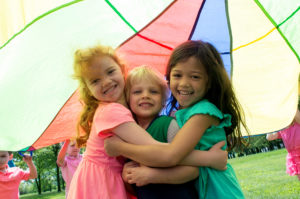“Sophia took my doll!” “She’s being loud!” “She knocked over my block tower!”
 Does this sound familiar? Tattling is a normal and common behavior in young children, and is a sign that they haven’t yet developed the emotional and social skills needed to problem solve.
Does this sound familiar? Tattling is a normal and common behavior in young children, and is a sign that they haven’t yet developed the emotional and social skills needed to problem solve.
They are starting to develop a sense of right and wrong, as they learn about rules. Children may take rules quite literally, quickly becoming “kid police” and alerting authorities.
Tattling can start a vicious cycle where each child blames the other, or it can be a teachable opportunity for conflict resolution. Below are some ways you can work with your child to develop that understanding.
- Determine motivation. Ask your child, “How is that a problem for you?” “How can we solve your problem?” or “Have you talked to your sister about that?” These questions don’t assign blame, but instead encourage him to think of a solution. You might not implement his solution, but his response can give you insight about why he tattled. For instance, he might say, “I think she should be punished,” which tells you he wanted to get someone in trouble.
- Point out tattling and its effect. “I hear that you’re tattling on your friend. How do you think she feels about that? Is there something you could have done besides telling me?” Then, say, “What are some ways you can both feel better and be good friends?”
- Teach the difference between tattling and getting help. Distinguish between tattling and getting help by giving concrete examples. “If you tell me that your sister stole your toy, you are tattling on her. However, you need to tell me if you she is hurt or in danger, for example, if she’s standing on the table and could fall.” When he comes to you for help, praise him by saying, “Thank you for trying to keep your sister safe.”
- Read books with your child to reinforce problem solving skills. With your child, read “A Bad Case of Tattle Tongue” by Julia Cook. The book is about a boy whose tongue turns yellow with purple spots when he tattles. He meets the Tattle Prince and learns important problem solving skills. After reading the book, ask your child to brainstorm different ways he could resolve conflicts without tattling.
In the classroom, teachers use songs, puppets, games, books and brain-builder activities to help nurture important social and emotional skills such as listening, understanding feelings, labeling emotions and resolving conflicts. Over time, children become empowered and confident to solve their problems on their own without tattling. They learn better ways to help themselves and others, and make and maintain friendships.
– Lauren Starnes, PhD – Director of Early Childhood Education

Taming Tattling
Taming Tattling
“Sophia took my doll!” “She’s being loud!” “She knocked over my block tower!”
They are starting to develop a sense of right and wrong, as they learn about rules. Children may take rules quite literally, quickly becoming “kid police” and alerting authorities.
Tattling can start a vicious cycle where each child blames the other, or it can be a teachable opportunity for conflict resolution. Below are some ways you can work with your child to develop that understanding.
In the classroom, teachers use songs, puppets, games, books and brain-builder activities to help nurture important social and emotional skills such as listening, understanding feelings, labeling emotions and resolving conflicts. Over time, children become empowered and confident to solve their problems on their own without tattling. They learn better ways to help themselves and others, and make and maintain friendships.
– Lauren Starnes, PhD – Director of Early Childhood Education